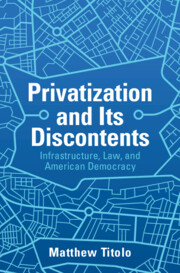Book contents
- Privatization and Its Discontents
- Privatization and Its Discontents
- Copyright page
- Dedication
- Contents
- Acknowledgments
- Introduction
- 1 Early Liberalism, Adam Smith, and the Seeds of the Infrastructural State
- 2 Forging the Infrastructural State
- 3 “A Wilderness of Turnpike Gates”
- 4 The Panic of 1837 and the Infrastructure Crash
- 5 “The Ground under Our Feet”
- 6 The Death of Laissez-Faire and the Rise of Infrastructure in the Cold War
- Conclusion
- Index
2 - Forging the Infrastructural State
1787–1837
Published online by Cambridge University Press: 08 June 2023
- Privatization and Its Discontents
- Privatization and Its Discontents
- Copyright page
- Dedication
- Contents
- Acknowledgments
- Introduction
- 1 Early Liberalism, Adam Smith, and the Seeds of the Infrastructural State
- 2 Forging the Infrastructural State
- 3 “A Wilderness of Turnpike Gates”
- 4 The Panic of 1837 and the Infrastructure Crash
- 5 “The Ground under Our Feet”
- 6 The Death of Laissez-Faire and the Rise of Infrastructure in the Cold War
- Conclusion
- Index
Summary
The case of internal improvements at the federal level from 1787 to 1837 suggests that American governance patterns were pragmatic and utilitarian, rather than committed to laissez-faire theory of the small state. Federal power can be used in a variety of ways to create a liberal capitalist state by building transportation and communication infrastructures. While the concessions in America’s constitutional model to small-state Republicans often thwarted the more ambitious plans, it was not laissez-faire theory that prevented the use of federal power for nation-building projects. When government in the first half of the century wanted to promote economic development, “no overriding theory held government back.” The liberal forms of governance that developed in America were not the Lockean minimal state that Louis Hartz famously imagined to be America’s continuous laissez-faire tradition. Rather, the American experience of internal improvements reveals the complicated entanglements of state, law, and capitalism in the nineteenth century and illustrates the continuing problems with neat categories of state and market, public and private, to describe the political economy of capitalism.
Keywords
- Type
- Chapter
- Information
- Privatization and Its DiscontentsInfrastructure, Law, and American Democracy, pp. 55 - 86Publisher: Cambridge University PressPrint publication year: 2023

